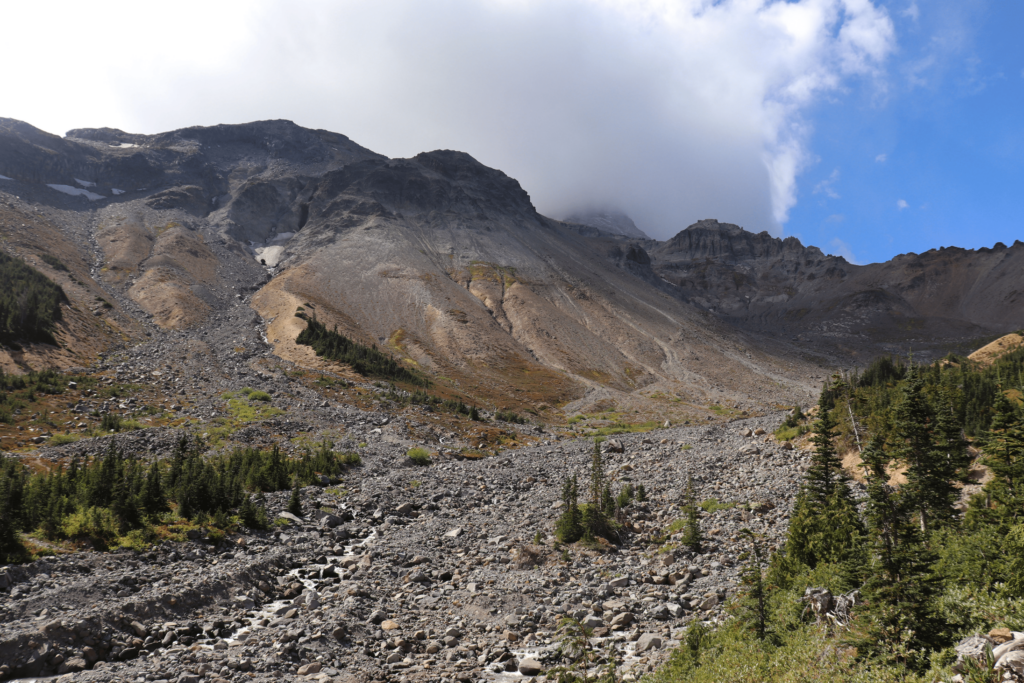The Ultimate Guide: Mount Rainier National Park
Mount Rainier National Park is a beautiful and unique national park located in the state of Washington. Mount Rainier, the highest mountain in the state, stands at 14,410 feet tall, the park bears its name. The park was first established in 1899 and is now a popular destination for hikers, campers, and outdoor enthusiasts. It is also one of the most visited National Parks in terms of skiing.
For a condensed view of the park feel free to check out rvResortScouts Mount Rainier National Park Information listing.
Park History / General Overview
Mount Rainier has a rich history dating back to the 1800s. The first recorded ascent of Mount Rainier was in 1870 by Hazard Stevens and Philemon Beecher Van Trump. The park was first established in 1899, making it the fifth national park in the United States.
The park’s main attraction is Mount Rainier, which stands at 14,410 feet tall and is the highest mountain in the state of Washington. The mountain is also an active volcano and is covered with glaciers, making it a unique and popular destination for hikers and outdoor enthusiasts.
The park offers a wide range of activities and attractions for visitors. Visitors can hike on the park’s many trails, camp in the park’s campgrounds, and explore the park’s natural wonders, including alpine meadows, wildflowers, and glaciers. So get ready to explore!
Visitors can also learn about the park’s history at the park’s main visitor center, located in the Longmire area. The visitor center offers exhibits and information on the park’s natural and cultural history, as well as information on the best hikes and activities.
Mount Rainier National Park is also home to many species of wildlife, including bears, mountain goats, and elk. Beware of the park’s wildlife and follow posted warnings and guidelines to ensure the safety of both visitors and the wildlife.
Getting Oriented
The park is divided into several different sections, each with its own unique features and attractions. The park’s main entrance is located in the southwest corner, near the town of Ashford. From there, visitors can access several different areas of the park, including:
- Longmire: This area is home to the park’s main visitor center and also the National Park Inn. It is also a starting point for many hikes, including the Wonderland Trail.
- Paradise: This area has stunning views of Mount Rainier and also the surrounding mountains. It is also the location of the Henry M. Jackson Memorial Visitor Center and the Paradise Inn.
- Sunrise: This area is located on the northeastern side of the park and offers great views of the park’s alpine meadows and wildflowers. It is also the location of the Sunrise Visitor Center and the Sunrise Lodge.
- Ohanapecosh: This area is located on the southeastern side of the park and contains hot springs and old-growth forests. It is also the location of the Ohanapecosh Visitor Center.
- White River: This area is located on the northeastern side of the park and has great hiking trails and views of the park’s glaciers. So bring your hiking boots.
Each area of the park offers different activities and attractions, so it’s important to plan ahead and decide which area you want to visit. The park’s main visitor center in Longmire is a great place to start and get information on the best hikes and activities. But get there early, as the visitor center can get busy later in the day.

Mount Rainier National Park Essentials
Mount Rainier is a great place to visit, but there are a few things that visitors need to know before they go.
Getting to Mount Rainier Park: The park is located in the state of Washington and can be accessed by car, bus, or train. Visitors can take I-5 to SR-12, which leads to the park’s main entrance near the town of Ashford. Visitors can also take the Amtrak train to the Tacoma or Seattle stations and then take a bus or rental car to the park.
Rules and Regulations: You must pay the entrance fee to enter the park. The park also has a number of rules and regulations in place to protect the park’s natural resources and ensure the safety of visitors. These include rules on wildlife viewing, camping, and hiking. Visitors should familiarize themselves with these rules before visiting the park.
Visitor Center: The park’s main visitor center is located in the Longmire area. It is a great place to start your visit and get information on the park’s history, natural wonders, and best hikes. The visitor center also offers exhibits and information on the park’s wildlife, geology and culture.
It’s important to note that the park’s facilities, including visitor centers and campgrounds, are closed for winter, typically from late September to late May. Visitors can still access the park during this time, but the park’s facilities and services are limited.
Things You Need To Know
When visiting Mount Rainier National Park, there are a few things that visitors should know in order to have a safe and enjoyable trip.
What to Pack: Visitors should pack warm clothing, waterproof gear, and enough food and water for the duration of their hike. It is also important to pack a first aid kit, a map and compass, and a flashlight or headlamp.
Amount of Food Needed: It’s important to bring enough food for the duration of your hike. Visitors should plan for at least one day’s worth of food, plus extra in case of emergencies. It’s also a good idea to bring high energy snacks.
Hiking Gear: Visitors should wear sturdy hiking boots or shoes and dress in layers. It’s also a good idea to bring a daypack to carry your supplies, including food, water, and extra clothing. Hiking poles can also be helpful for steep or uneven terrain.
Animals In The Area: The park is home to a variety of wildlife, including bears, mountain goats, and elk.
Cost of Trip: The park has an entrance fee, and additional fees may apply for camping or parking at specific trailheads. Visitors can check the park’s website or visit the park’s visitor center for current fee information.
Family Activities: Mount Rainier National Park offers a variety of activities for families, including hiking, wildlife viewing, and picnicking.
Conservation: Mount Rainier is home to a variety of unique and fragile ecosystems that need to be protected. Follow the rules, stay on designated trails, and throw out all of your trash.
RV Dos and Don’ts: Visitors who plan to camp in an RV should check the park’s website for information on RV camping and parking. RVs are permitted in specific campsites and parking areas and have specific length and weight restrictions.
Best Hikes Within Mount Rainier National Park
Mount Rainier offers a variety of hiking trails for visitors of all skill levels. Here are five of the best hikes in the park:
- Skyline Trail: This trail is a popular hike that offers visitors great views of Mount Rainier and the surrounding wilderness. The trail is 3.5 miles round trip and takes about 3–4 hours to complete. The hike is moderate in difficulty.
- Grove of the Patriarchs: This hike is a 1.5-mile round trip and takes about 1–2 hours to complete. It is considered an easy hike and offers visitors a chance to see old-growth Douglas firs and Western red cedars.
- Nisqually Vista Trail: This hike is a 1-mile round trip and takes about 1 hour to complete. It is considered an easy hike and offers visitors great views of the Nisqually Glacier.
- Tolmie Peak Trail: This hike is a 3.5-mile round trip and takes about 3–4 hours to complete. The hike is a moderate hike. It offers visitors great views of the park and the surrounding wilderness.
- Paradise Glacier Trail: This hike is a 5-mile round trip and takes about 5–6 hours to complete. This hike is a difficult hike and offers visitors a chance to see the park’s glaciers up close. So bring a camera!
It’s important to note that the park’s trails can be affected by snow or other weather conditions, and hikers should be prepared for the weather and trail conditions. Visitors should also check the park’s website or visit the park’s visitor center for current trail conditions and closures before starting a hike.
Accommodations
Mount Rainier National Park offers a variety of accommodations for visitors, including camping, lodging, and RV hookups. Here is a brief overview of the park’s accommodations:
Camping: The park has five campgrounds, which can accommodate tents and RVs. Visitors can make reservations in advance or on a first-come, first-served basis. Campsites have picnic tables, fire rings, and vault toilets. It is important to keep in mind that there is only one hookup for RVs, so plan accordingly.
Lodging: The park has two historic lodges, which can accommodate visitors year-round. Visitors can make reservations in advance. The lodges offer comfortable accommodations, with amenities such as private bathrooms, dining rooms, and lounges.
RV Hookups: The park has one RV hookup site, which can accommodate RVs up to 40 feet in length. Visitors can make reservations in advance or on a first-come, first-served basis. The site has electric and water hookups, and a dump station.
Backcountry Camping: The park also offers backcountry camping for visitors who want to experience the park’s wilderness. Visitors must obtain a backcountry permit and follow specific rules and regulations. Backcountry campsites have no amenities and are located in remote areas of the park.
It’s important to note that the park’s accommodations can fill up quickly, especially during peak season. Visitors should plan ahead and make reservations in advance if possible. Visitors should also be aware of the park’s rules and regulations for camping, lodging, and RV hookups, and should follow them to ensure the safety and enjoyment of all park visitors.
Safety
Mount Rainier National Park is a beautiful and wild place, but visitors should be aware of the potential hazards and take necessary precautions to stay safe. Here are a few safety tips for visitors to the park:
Weather: The park’s weather can be unpredictable, with sudden changes in temperature, wind, and precipitation. Visitors should be prepared for the weather and check the park’s website or visit the park’s visitor center for current conditions and forecasts.
Hiking: Visitors should be prepared for their hike, including wearing appropriate clothing and footwear, and bringing enough food, water, and other supplies.
Wildlife: Visitors should be aware of the park’s wildlife, including bears, mountain goats, and elk. Visitors should follow the park’s rules and regulations for wildlife viewing and safety. It is also important to store food properly and maintain a safe distance from wildlife.
Medical Emergencies: Visitors should be aware of the park’s medical facilities and emergency services. The park has a medical clinic and a search and rescue team. Visitors should be prepared for medical emergencies and bring a first aid kit.
What’s In The Surrounding Area
The park is surrounded by a variety of natural, cultural, and recreational opportunities for visitors to explore. Here are a few things to see and do in the surrounding area:
Mount Rainier Scenic Railroad: This train ride takes visitors on a scenic journey through the foothills of Mount Rainier. The train ride is a great way to see the park’s beauty and learn about its history.
Mount St. Helens National Volcanic Monument: This national monument is located about 50 miles northwest of Mount Rainier National Park. Visitors can learn about the volcano’s eruption in 1980 and see the recovery of the area.
White Pass Ski Area: This ski area is located about 60 miles east of Mount Rainier. Visitors can enjoy skiing, snowboarding, and other winter activities. So bring the whole family.
Ashford: This small town is located just outside the park’s entrance and offers a variety of amenities for visitors, including lodging, dining, and shopping.
Seattle: This bustling city is located about 90 miles southwest of Mount Rainier. Visitors can explore the city’s famous landmarks, museums, and cultural attractions.
Mount Rainier National Park Wrap Up
In conclusion, Mount Rainier is a beautiful and unique national park that offers visitors a wide range of activities and attractions. From hiking and camping to exploring the park’s history and natural wonders, there is something for everyone to enjoy at Mount Rainier. With safety in mind and proper planning, it can be a wonderful and memorable experience for all.


